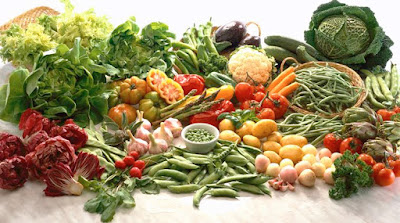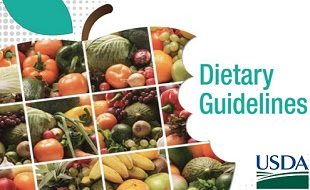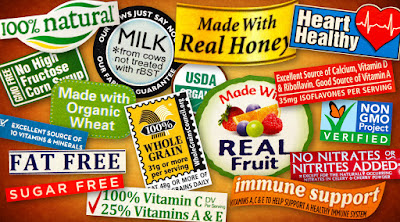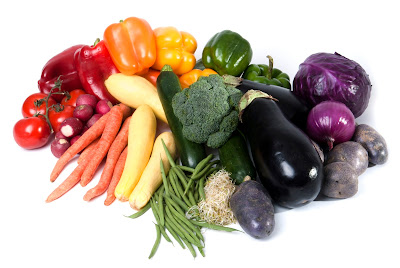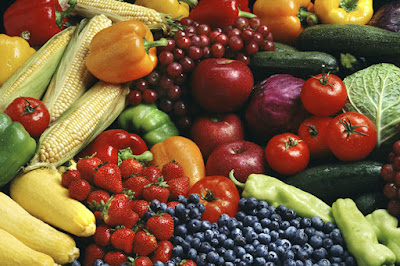Let’s discuss the familiar nutrients first: carbohydrates, fats, and proteins. These three nutrients provide our bodies with
calories. Calories are used quickly by
our bodies in energy metabolism, or they are stored in the form of glycogen or
adipose (fatty) tissue.
Carbohydrates
Carbohydrates are various combinations of sugar units, or
saccharides and are the major energy source for the body. Each gram of carbohydrate contains 4
calories. Since the average person
requires approximately 2000 calories per day and about 60% of our calories come
from carbohydrates roughly 1200 calories per day come from carbohydrates.
Carbohydrates occur in three forms, depending on the number
of saccharide (sugar) units that make up the molecule. Those that contain only one saccharide unit
are classified as monosaccharides (glucose, or blood sugar), those with two units are disaccharides ( sucrose, or table
sugar), and those with more than two units are polysaccharides (starches).
Americans now consume about 150 pounds of sweeteners each
year – usually in colas, candies, and pastries, which few additional
nutritional benefits. For years, excess
sugar intake was blamed for a number of serious health problems, including
obesity, mineral deficiencies, behavioral disorders, dental cavities, diabetes
mellitus, and cardiovascular disease.
However, with the exception of dental cavities, current scientific data
do not confirm that sugar itself directly causes any of these health
problems. Today, it is recommended that
no more than 10% of our total calories come from simple sugars.
Much of the sugar we consume is hidden. For example, it is an ingredient in food such
as ketchup, salad dressing, cured meat products, and canned vegetables and
fruits. High-fructose corn syrup, often
found in these items, is a highly concentrated sugar solution.
Starches are complex carbohydrates composed of long chains
of sugar units. However, these starches
should not be confused with the adjective “starchy.” When people talk about
starchy foods, they usually mean complex carbohydrates, or “heavy” foods. True starches are among the most important
sources of dietary carbohydrates.
Starches are found primarily in vegetables, fruits, and grains. Eating true starches is overall very
nutritionally beneficial because most starch sources also contain much needed
vitamins, minerals, plant protein, and water.
Fats
Fats (lipids) are an important nutrient in our diets, as
they provide a concentrated form of energy (9 calories per gram). Fats provide a feeling of satiety and keep us
from feeling hungry. Because fats take
longer to leave your stomach than either carbohydrates or proteins do, our
stomachs feel full for a longer period of time, decreasing our appetite. Fat also helps give food its pleasing taste,
or palatability. Fats carry the fats
soluble vitamins A, D, E and K. without
fat, these vitamins would quickly pass through the body. Fat also insulates our bodies to help us
retain heat.
Dietary sources of fat are often difficult to identify. The visible fats in our diet, such as butter,
salad oils, and the layer of fat on some cuts of meat, represent only about 40%
of the fat we consume. Most of the fat
we eat is hidden in the food.
At the grocery store, the fat content of some foods is
expressed as a percentage of the product’s weight. For example, the different type of milk
available include skim milk (no fat), low-fat milk (½%), reduced-fat milk (1%
to 2%), and whole milk (3% to 4%). The
labeling term “reduced-fat” for 1% and 2% milk was introduced in 1997 to
indicate that these types of milk are no longer considered “low-fat.”
The current recommendation is that no more than 25% to 30%
of our calories come from fat. Children
under 2 years of age, however, need a certain amount of fat in their diets for
growth. Check with your doctor before
restricting you are the amount of fat in a young child’s diet.
All dietary fat is made up of combination of three forms of
fat: saturated, monounsaturated, and polyunsaturated, based on chemical
composition. Paying attention to the
amount of each type of fat in our diet is important because of the know link to
heart disease. Not all fats are created
equal. Saturated fats, including those
found in animal sources and vegetable oils to which hydrogen has been added
(hydrogenated), becoming trans-fatty
acids, need to be carefully limited in a healthy diet.
Concern over the presence of trans-fatty acids (an altered
form of a normal vegetable oil molecule) is associated with changes detrimental
to the cell membrane, including those cells lining the artery wall. Among the changes being suggested is an
increase in calcium deposits. This could
result in a rough surface, leading to plaque formation.
Processing can change the structure of fat, making it more
saturated. As a result, the oils become
semisolid and more stable at room temperature.
The term trans describes the
chemical makeup of a fatty acid. Most
trans fatty acids come from hydrogenated oil, which is found in foods such as
stick margarine, peanut butter, and crackers.
They are popular in food manufacturing because they can extend the shelf
life of the food: the oil stays mixed in the food and doesn’t rise to the top,
and the food doesn’t become too soft at room temperature. Many foods are fried with these fats in the
fast-food industry.
Tropical Oils
Although all cooking oils (and fats such as butter, lard,
margarine, and shortening) have the same number of calories by weight (9
calories per gram), some oils contain high percentages of saturated fats. All oils and fats contain varying percentages
of saturated, monounsaturated, and polyunsaturated fats. However, the tropical oils- coconut, plan,
and palm kernel – contain much higher percentages of saturated fats than do
other cooking oils. Coconut oil, for
example, is 92% saturated fat. Tropical
oils can still be found in some brands of snack foods, crackers, cookies,
nondairy creamers, and breakfast cereals, although they have been removed from
national brands. Do you check for
tropical oils on the ingredients labels of the foods you select?
Cholesterol
There has been a great deal of focus and concern over cholesterol
levels. Cholesterol is white, fat-like
substance, found in cells of animal origin.
It is not found in any vegetable product, so products such as peanut
butter and margarine that claim they are cholesterol free never had it in the
first place.
Cholesterol is used to
synthesize cell membranes and also serves as the cell starting material for the
synthesis of bile acids and sex hormones.
Although we consume cholesterol in our diet, in such foods as shrimp and
other shell-fish, animal fat, and milk, you don’t need to obtain cholesterol
from external sources – the human liver can synthesis enough of the substance
to meet of the body’s needs. It is
important to note that some foods high in cholesterol may provide other
important nutrients and could remain in a healthy diet on a modest basis. A high level of cholesterol has been reported
to be a risk factor in the development of cardiovascular disease. There are number of medical conditions that
can give rise to high blood cholesterol such as liver disease, kidney failure,
hypothyroidism, and diabetes. Certain
medications, (some diuretics, for example) can also raise blood cholesterol,
irrespective of diet.
Considerable evidence
suggests that increased intake of saturated fats may increase serum (blood)
cholesterol levels. Nutritionists
recommend that people restrict their dietary intake of cholesterol to 300 mg or
less per day. In other words, no more
than 30% of your caloric intake should come from fat, with 7-10% from saturated
fats, 10-15% from monounsaturated fats, and 10% from polyunsaturated fats.
Trans fats can act like saturated fat, potentially raising
LDL blood cholesterol levels and decreasing HDL cholesterol. In order to reduce your intake of trans fat,
make sure you check the labels on foods to see if they list “partially
hydrogenated vegetable oil” as one of the ingredients. Foods such as cakes, cookies, crackers, snack
foods, stick margarine, vegetable shortening and fried foods are most likely to
have hydrogenated vegetable oil as one of the ingredients. This also the reason nutritionists encourage
us to use butter rather than stick margarine.
Low – Fat Foods
Low fat and low calorie are not the same but often people
confuse the two. Fat-free, low-fat, or
reduced-fat foods have been popular for many years with people thinking they
can eat as much as they want of these foods.
This is far from true as a fat-free or reduced-fat product may have as
many if not more calories per serving than regular products. For example, two tablespoons of fat-free
caramel topping. Because fat helps you
to feel fuller for a longer period of time, individuals tend more of the
fat-free foods in order to feel satiated, thus consuming more calories. In general, the lower the fat the higher the
price tag as the food industry recognized that American are willing to pay more
for reduced-fat and fat-free labels.
However, this may be changing as people have realized that lower fat
with potentially higher calories doesn’t equal weight loss or healthy weight management. With subway trading in cookies for a fruit
roll and soda for a 100 percent juice carton in its kids-pak meals and
McDonald’s offering a piece of fresh fruit in lieu of French fries for its
Happy Meals and touting salad for adult fare, the fast-food tide seems to be
turned from supersized and super fat toward healthier choices.
Proteins
Proteins are found in every living cell. They are composed of chains of amino
acids. Of the twenty naturally occurring
amino acids, the body can synthesize all but nine essential amino acids from
the foods we eat. A food that contains
all nine essential amino acids is called a complete
protein food.
Examples are animal
products, including milk, meat, cheese, and eggs. A food source that does not contain all nine
essential amino acids is called an incomplete
protein food. Vegetables, grains,
and legumes peas or beans – including
chickpeas, butter beans, soybean curd [tofu], and peanuts) are principle
sources of incomplete protein. For some
people, including vegan vegetarians, people with limited access to animal-based
food sources, or those who have significantly limited their meat, egg, and
dairy product consumption, it is important to understand how essential amino
acids can be obtained from incomplete protein sources. This requires the careful selection of plant
foods in combinations that will provide all of the essential amino acids, as
shown in the following list:
·
Sunflower seeds/green peas
·
Navy beans/barley
·
Green peas/corn
·
Red beans/rice
·
Sesame seeds/soybeans
·
Black-eyed peas/rice and peanuts
·
Green peas/rice
·
Corn/pinto beans
When even one essential amino acid is missing from the diet,
a deficiency can develop, Soybeans provide the same high quality protein equal
to that of animal protein. Furthermore,
soybeans contain no cholesterol or saturated fat and can actually lower blood lipid levels,
reducing the risk of heart disease.
Protein primarily promotes growth and maintenance of body
tissue. However, when caloric intake
falls, protein is broken down and converted into glucose. This loss of protein can impede growth and
repair of tissue. Protein also is
primary component of enzyme and hormone structure. It helps maintain the acid-base balance of our bodies and is a source of energy (4
calories per gram consumed).
Nutritionists recommend that 12% to 15% of our caloric intake be from
protein, particularly that of plant origin.
The RDA for adults is 58 grams of dietary protein for men and 46 grams
for women each day.
Vitamins
Vitamins are organic compounds that are required in small
amounts for normal growth, reproduction, and maintenance of health. Vitamins differ from carbohydrates, fats, and
proteins because they do not provide calories or serve as structural elements
for our bodies. Vitamins are coenzymes.
By facilitating the action of sponses, including energy production,
use of minerals, and growth of healthy tissue.
Vitamins can be classified as water soluble (capable of being dissolved in fat or lipid
tissue). Water soluble vitamins include
the B-complex vitamins and Vitamins C.
most of the excess of these water soluble vitamins is eliminated from
the body in the urine. The fat soluble
vitamins are vitamins A, D, E, and K.
Excessive intake of these vitamins causes them to be stored in the body
in the adipose (fat) tissue. It is
therefore possible to consume and retain too many of these vitamins,
particularly vitamins A and D. because
excess fat soluble vitamins are stored in the body’s fat, organs that contain
fat, such as the liver, are primary storage sites.
Because water soluble vitamins dissolve quickly in water,
it’s important not to lose them during the preparation of fresh fruits and
vegetables. One method is not to
overcook fresh vegetables. The
vegetables are steamed or boiled, the more water soluble vitamins will be
lost. Some people save the water in
which vegetables were boiled or steamed and use it for drinking or
cooking. More vitamins are retained with
microwave cooking than with stove top cooking.
To ensure adequate vitamin intake, a good approach is to eat
a variety of foods. Unless there are
special circumstances, such as pregnancy, lactation, infancy, or an existing
health problem, nearly everyone who eats a reasonably well-rounded diet
consumes enough vitamins to prevent deficiencies. People often think taking mega doses of
vitamins such as vitamin C can be health-enhancing, but actually the reverse is
true. Taking large doses of vitamin C
from a dietary supplement can put a strain on your kidneys, causing kidney
stones and diarrhea. Too much niacin,
vitamin B6, and folate can also be harmful.
Some recommend that supplements be taken with food, since
they’re really components of food and help the body metabolize other food
components. The fat-soluble nutrients
should be taken with a little oil or fat to enhance absorption. The water-soluble nutrients are easily
absorbed without food, but may work better when taken with meals. In addition, some people complain of stomach
upset when they take vitamins on an empty stomach.
Unfortunately, not all people eat a balanced diet based on a
variety of foods. Recent studies suggest
that a somewhat higher intake of vitamins A, C, and E for adults might reduce
the risk of developing cancer, atherosclerosis, and depressed levels of high-density
lipoprotein (HDL) cholesterol; however, several unanswered questions remain,
including the amounts needed for effectiveness.
Consuming an adequate amount of folic acid before and during
pregnancy has been shown to reduce the incidence of birth defects. To ensure adequate folic acid intake (400
micrograms/day), in 1997 the Food and Drug Administration (FDA) began to
require that bread and cereal products be supplemented with folic acid. The goal of this requirement is for pregnant
women and women of child-bearing age to receive at least 140 micrograms/day
through dietary intake. Taking a daily
multivitamin before and during pregnancy would easily provide the remaining
amount of folic acid necessary to promote fetal neural tube closure (thus preventing
spina bifida). Folic acid is also
considered important in the prevention of cardiovascular disease.
At the same time that many health experts are recommending
some vitamin supplementation, the FDA has prohibited manufacturers of food
supplements, including vitamins, from making unsubstantiated claims for the cure and prevention of disease. Supplement manufacturers fought against the
implementation of this regulation by suggesting to the public that vitamins
might become available only by prescription.
This did not happen. Today,
manufacturers of folic acid supplements may make claims about the product’s
ability to prevent neural tube defects in infants.
Minerals
Nearly 5% of the body is composed of inorganic materials,
the minerals. Minerals function primarily as structural
elements (in teeth, muscles, hemoglobin, and hormones). They are also critical in the regulation of
body processes, including muscle contraction, heart function, blood clotting,
protein synthesis, and red blood cell formation.
Approximately twenty-one minerals have been
recognized as essential for good health.
Unlike vitamins, minerals are inorganic and can’t be destroyed by heat
or food processing.
Major minerals are
those that exist in relatively high amounts in our body tissues. The RDA recommends taking 250 mg of each one
daily. Examples are calcium, phosphorus,
sulfur, sodium, potassium, and magnesium.
Examples of trace elements in body tissues, include zinc, iron, copper,
selenium, and iodine. Trace elements are
required only in small quantities, fewer than 20 mg daily of each, but they are
essential for good health. As with
vitamins, the safest, most appropriate way to prevent a mineral deficiency is
to eat a balanced diet. However,
calcium, a major mineral, can be taken as a supplement to help prevent
osteoporosis.
Water
Water may well be our most essential nutrient, since without
water most of us would die from effects of dehydration in less than 1
week. We could survive for weeks or even
years without some of the essential minerals and vitamins, but not without
water. More than half our body weight
comes from water. Water provides the
medium for nutrient and waste transport, controls body temperature, and
functions in nearly all of our body’s biochemical reactions.
Most people seldom think about the importance of an adequate
intake of water and fluids. The average
adult loses about 10 cups of water daily through perspiration, urination, bowel
movements, and breathing. Adult require
about six to ten glasses a day, depending on their activity level and
environment. People who drink beverages
that tend to dehydrate the body (tea, coffee, and alcohol) should increase
their water consumption. To see if you
are drinking enough fluid, check your urine.
A small amount of dark-colored urine can be an indication that you are
not consuming enough fluids. Needed
fluids are also obtained from fruits, vegetables, fruit and vegetable juices,
milk, and noncaffeinated soft drinks.
Excessive water consumption by infants, however, can dilute sodium
stores in the body to dangerously low levels, possibly causing death. Also, dentists are increasingly concerned
about the abnormally high number of dental caries (cavities) seen in children who
have consumed bottled water rather than fluoridated tap water.
Fiber
Although not considered a nutrient by definition, fiber is
an important component of sound nutrition.
Fiber consists of plant material that is not digested but moves through
the digestive tract and out of the body.
Cereal, fruits, and vegetables all provide us with dietary fiber.
Fiber can be classified into two large groups on the basis
of water solubility. Insoluble fibers are those that can absorb water from the intestinal
tract. By absorbing water, the insoluble
fibers give the stool bulk and decrease the time it takes the stool to move
through the digestive tract. In
contrast, soluble fiber turns to a
“gel” in the intestinal tract and binds to liver bile, to which cholesterol is
attached. Thus the soluble fibers may be
valuable in removing cholesterol, which lowers blood cholesterol levels. How much fiber do you need? Adults should eat
from 25 to 35 g of fiver each day; however, most American adults only eat 11 g
per day. Fiber has many benefits,
including helping to curb your appetite and prevent overeating because it is
filling, requires more chewing, stays in the stomach longer, and absorbs water,
adding to the feeling of fullness. Fiber
also helps to slow the absorption of sugar from the intestines, thus steadying
the blood sugar and slowing down the absorption of fat from the foods you
eat. Consuming adequate amounts of fiber
has an important effect on reducing serious medical problems because soluble
fiber lowers LDL cholesterol and protects against cardiovascular disease while
insoluble fiber protects against developing colon cancer.
In recent years, attention has been given to three forms of
soluble fiber – oat bran, psyllium (from the weed plantain), and rice bran –
because of their ability to lower blood cholesterol levels.
Oat
blood can lower cholesterol levels by five to six points in people whose
initial cholesterol levels are moderate high.
To accomplish this reduction, a daily consumption of oat bran equal to a
large bowl of cold oat bran cereal or three or more packs of instant oatmeal
would be necessary. Oatmeal can also be
eaten as a cooked cereal or used in other foods, such as hamburgers, pancakes,
or meatloaf.



















